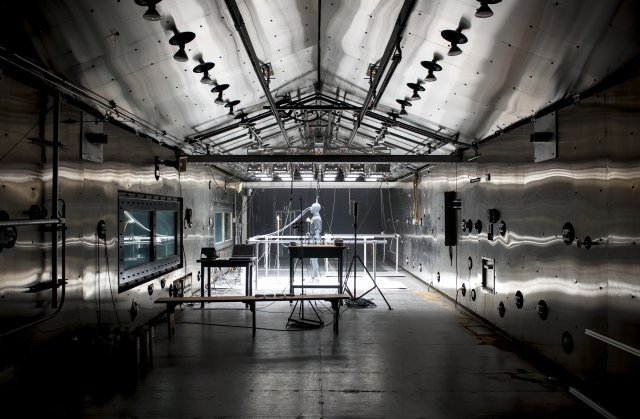'Maj. Clo' Feels the Heat at Natick

If he's a bit of a hot head these days, you'll have to excuse him. "Maj. Clo" is just doing his job.
Lately, he's literally been feeling the heat at work, because Maj. Clo is the thermal test manikin at the U.S. Army Research Institute of Environmental Medicine, known as USARIEM.
Maj. Clo has been getting a real grilling recently as USARIEM researchers placed him under solar lamps at the Doriot Climatic Chambers of the Natick Soldier Research, Development and Engineering Center in an effort to measure the thermal burdens of different-colored garments.
"Different materials absorb different amounts of solar radiation," said Tony Karis, a research physical scientist at USARIEM, "and this testing will help us quantify how much solar radiation is being absorbed."
Doriot's Tropic Chamber became just the place to do that in January 2013, when it was outfitted with a Solar Simulation Unit that brought daylight conditions indoors. The 18 1,500-watt metal halide vapor lamps, arranged in three rows of six apiece, allow Doriot to produce artificial sunlight that replicates different climates in every season at various times of day -- in the mountains, desert and everywhere in between.
"All of the tests in the past that we've done for 50 years in this facility have been without sun," said Josh Bulotsky, Doriot's manager. "This is like real sunlight. You don't realize how really hot it is."
It was only a matter of time before Maj. Clo and his 5-foot-9-inch carbon fiber, epoxy resin and copper frame, featuring 200 sensors and simulated sweat pores, would be deployed there.
"There (are) not too many places that have these solar lamps that we can actually use a full-size manikin," Karis said. "A lot of times, it's done on a smaller scale. To be able to use a full-size manikin in an operational room is something that -- as far as I know -- no other place is doing."
Karis explained that USARIEM researchers are measuring how much heat is being transmitted from the clothing to Maj. Clo.
"Another thing that complicates this is the coverage," Karis said. "As coverage changes, the absorbtivity changes, too. Short-sleeve shirt versus long-sleeve shirt, shorts versus long pants -- each one of them, there's different coverage, so there are different thermal burdens to each ensemble."
Karis and his USARIEM colleagues have placed Maj. Clo in the chamber at 80 degrees and 50 percent relative humidity with a 3.5 mph breeze. Then they have hit him with either 1,000 or 500 watts of solar load.
"A thousand watts is a good choice for the highest value in most locations during the summer, but more extreme conditions may occur," Karis said. "We also did 500 watts, which may be a more representative value for conditions between late morning and early afternoon for the warmer part of the year.
"The manikin measures heating over different parts of the body, and the heating just due to solar loading can vary widely for different parts of the body. But that's the idea -- to monitor and measure the solar load on different garments and its effects on different parts of the body."
This validates models that USARIEM already has.
"It's nice to be reassured that your models are predicting correctly," Karis said. "We will use this information to make our models more robust."
Karis said USARIEM had done about a dozen tests with another half-dozen remaining. One day, the data could have real-world applications.
"The battlefield has changed from a jungle battlefield or woodland," Karis said. "Now we're in open desert or mountain regions where there's very little overhead coverage from plant life. So now you're in direct sunlight for the majority of the time."














